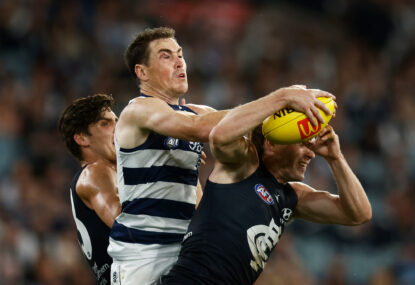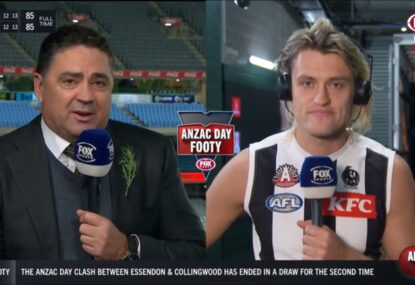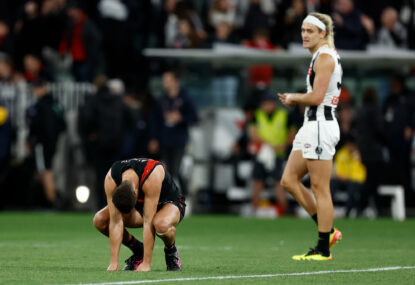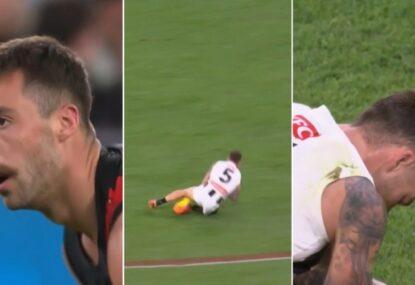The N team is short on depth, but high on quality, with one team’s era heavily featured.
Back line
Ian Nankervis (Geelong 1967-83)
325 games, 203 goals
Starting his career primarily as a forward pocket or rover, Ian Nankervis shifted to the back pocket and quickly made the position his own. Skilled, determined and disciplined, he won Geelong’s best and fairest three times, and represented Victoria on 12 occasions. Nankervis captained Geelong from 1978 to 1982, and led Geelong’s goal-kicking in 1975. When he retired, he held the club record for games played, and held it until overtaken by Corey Enright. Nankervis was named as an emergency in Geelong’s Team of the Century.
Kevin Neale (St Kilda 1965-77)
256 games, 301 goals
Kevin Neale is best remembered for his feats at full forward, leading St Kilda’s goal-kicking in four straight years, including five in the 1966 premiership. However, he also spent parts of his career in defence as a back pocket/resting ruckman, so I have slotted him at full back here. With a rough and tumble approach to playing and strong marking, Neale could be equally effective at either end of the ground, and won St Kilda’s best and fairest award in 1973. He retired having played the most finals matches in club history, and was named in the back pocket of St Kilda’s Team of the Century.
Wally Naismith (Fitzroy 1902-10, Melbourne 1911-12)
179 games, 20 goals
For the first decade of the 1900s, Wally Naismith was a mainstay in the Fitzroy defence. Starting on the half back flank for the losing 1903 grand final, he moved to the back pocket and was instrumental in the Lions’ 1904 and 1905 premierships. After the 1910 season he was cleared to Melbourne where he played every game for the two years he was on the list, before retiring. Naismith served as an umpire in 11 VFL matches, and as a boundary umpire for 207 – including six grand finals.
Half back line
Ernest Newling (Geelong 1900-10)
150 games, 22 goals
Ernest Newling was a tough and fair defender for Geelong over a decade, being seen as one of the club’s stars in a poor era. He showed equal effectiveness in defence or as a follower, and managed such high quality play despite being blind in one eye. Newling was the third Geelong player to reach 150 games, however he was injured during this game and forced to retire as a result. He is listed as a member in Geelong’s Hall of Fame.
Laurie Nash (South Melbourne 1933-37, 1945)
99 games, 246 goals
When he was asked who the greatest player of all time was, Laurie Nash would boom, “Son, I see him in the mirror every morning when I shave.” His father, Bob Nash, was considered for this team as a star for Collingwood in the early 1900s, but missed out. Laurie Nash, meanwhile, came to Victoria from Tasmania initially for cricketing purposes, but starred on the footy field as well, being universally seen as best on ground in South Melbourne’s 1933 premiership. Prolific in the air and with a thumping kick, in 1934 Nash started a State of Origin game at centre half forward but moved to full forward when Bill Mohr was injured – he promptly kicked 18 goals for the game! He led South Melbourne’s goal-kicking in 1937 before transferring to Camberwell in the VFA, and returned to South in 1945 after his war service was complete, leading the club’s goal-kicking again. Nash also played in two Test matches for Australia, and was considered one of the best fast bowlers in the country throughout the 1930s.
Chris Newman (Richmond 2002-15)
268 games, 56 goals
In contrast to Laurie Nash, Chris Newman was an unobtrusive yet effective defender for Richmond for over a decade. Close checking yet able to rebound effectively, he was a regular from his debut except for his recovery from a broken leg in 2006. In 2009, Newman was appointed as Richmond captain, a role he held for four years before stepping down. He was nominated for Richmond’s Goal of the Century for a monster torpedo against Fremantle, and represented Australia in the 2005 International Rules series.

(Photo by Michael Dodge/AFL Media/Getty Images)
Centre line
Robert Neal (Geelong 1974-86, St Kilda 1987-88)
220 games, 52 goals
When he made his debut for Geelong, Robert Neal was only 17 years old. He went on to add another 199 games for the Cats through 13 seasons, developing into one of the most prominent wingmen of the time with great pace and sublime ball handling skills. Nicknamed ‘Scratcher’ due to his upbringing as a potato farmer, Neal crossed to St Kilda in 1987 for two more seasons before retiring. He shares Geelong’s number 35 jumper with fellow all-time alphabet team members Paul Chapman, Patrick Dangerfield and Billy Goggin.
Bruce Nankervis (Geelong 1970-83)
253 games, 80 goals
Bruce Nankervis was Neal’s teammate for a decade before retiring, along with brother Ian. At the start of his career he was an inconsistent flanker either forward or back, but when he shifted into the centre he improved to such an extent that he won Geelong’s best and fairest in two straight seasons as someone who could nullify an opposing star as well as find his own ball. Nankervis captained Geelong in 1976 and 1977 before handing the reins to his brother, and represented Victoria in 12 State of Origin matches.
Merv Neagle (Essendon 1977-85, Sydney 1986-90)
203 games, 71 goals
Flashy, creative, and exciting, Merv Neagle was one of the catalysts for Essendon’s rise to prominence in the early 1980s. He twice finished as runner up in the club best and fairest award, and also finished second in the Brownlow Medal in 1980. Three times Neagle was selected to play for Victoria, and he played in the 1984 premiership before missing the 1985 flag through injury. After this, he crossed to Sydney where he gave good service for a few years before injury stalled his career.
Ruck line
John Nicholls (Carlton 1957-74)
328 games, 307 goals
John Nicholls is the greatest player in Carlton’s history, an imposing ruckman whose menacing glare would give anyone pause, and with a footy brain second to none. The great irony is that when Carlton officials lobbed on the Nicholls’ doorstep it was brother Don (who was a fine player in his own right) that was the initial target and John was the tag along! Five best and fairest awards, three premierships, eight years as captain, a record 31 games for Victoria, and a club record games total later, Nicholls was a fair return on investment. His duels with ‘Polly’ Farmer were part of the legend of 1960s VFL footy, and his coaching mastery was seen when he led a shock result in 1972 by simply outgunning the Tigers. Nicholls was named in the ruck in Carlton’s Team of the Century, in the back pocket of the VFL/AFL Team of the Century, and was inducted as an inaugural AFL Legend.
Ron Nalder (Hawthorn 1959-66)
121 games, 44 goals
Capable of playing anywhere on the ground, it was in the midfield that Ron Nalder was most effective. The regard in which he was held at within Hawthorn’s walls was exemplified when he was given the number three jumper two years into his career. He wore this in the club’s drought breaking 1961 flag, kicking a goal, before also playing in the 1963 grand final. The Roar’s Stephen Shortis wrote a nice retrospective on Nalder last year.
Lachie Neale (Fremantle 2012-18, Brisbane 2019-)
169 games, 89 goals
Lachie Neale’s career is not yet close to completion, but his body of work so far has made him undeniable in this team. At Fremantle he started his career slowly, playing 23 games in his first two seasons including the unsuccessful 2013 grand final, before blossoming into a tough and skilled ball-winning midfielder. His durability and consistency saw him win Fremantle’s best and fairest in 2016 and 2018, as well as being named in the 25 since ‘95 team on the interchange bench. Brisbane paid a premium to trade for Neale in 2019, and this was justified when he won the best and fairest and was named All Australian for the first time. Thus far in 2020 Neale has stamped himself as a genuine star and could well win the Brownlow Medal this year.
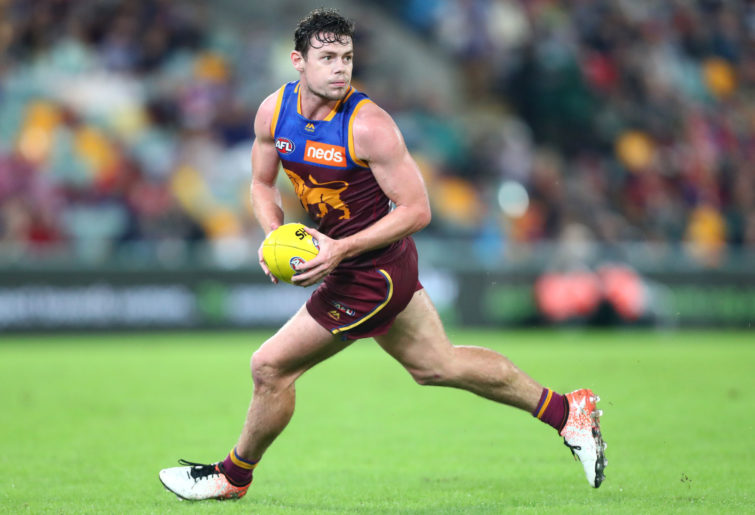
(Photo by Chris Hyde/Getty Images)
Half forward line
John Northey (Richmond 1963-70)
118 games, 192 goals
Although he is remembered more as a coach, with stints at Sydney, Melbourne, Richmond, and Brisbane, John Northey was an effective half forward for most of the 1960s for Richmond. Nicknamed ‘Swooper’, he had a great ability to collect a loose ball and pass it on to a teammate. He was capable of big bags on occasion, six times topping five goals with a best of eight against Melbourne in 1968. Northey played in Richmond’s 1967 and 1969 premierships before departing for the Western Suburbs in Sydney’s local league as captain-coach.
Alan Noonan (Essendon 1966-76, Richmond 1977)
192 games, 434 goals
Alan Noonan’s signature was chased by both Essendon and Richmond, but it was with the Bombers that he would star up forward. Leading Essendon’s goal-kicking on seven occasions, Noonan was a great mark and very strong at ground level for his height. In 1970 a shoulder injury and National Service disrupted his career, but he returned to represent Victoria in 1972 and 1973. Noonan was named vice captain in 1997 and 1975, occasionally leading the team when captain Des Tuddenham was injured. He finished his career with a season at Richmond before retiring via the VFA.
Ken Newland (Geelong 1965-75, 1977-78, Footscray 1976)
216 games, 255 goals
When Ken Newland debuted, he was the youngest player in Geelong’s history, and was one of the youngest in VFL history to rack up 100 games. Classy and confident from the start of his career, he was most often used at half forward but with stints in the centre. Newland played in the unsuccessful 1967 grand final, where his most notable act – as a stepladder for Royce Hart’s iconic mark – took place. Towards the end of his career he spent a season with Footscray before returning to Geelong.
Forward line
John ‘Sam’ Newman (Geelong 1964-80)
300 games, 110 goals
Sam Newman’s role on The Footy Show as provocateur has obscured his quality as a player for over 15 seasons. Developing as a ruckman under ‘Polly’ Farmer, Newman was able to use his body to great effect at ruck contests and with creative handballing could open up the flow of the game. He won Geelong’s best and fairest in 1968 and 1975, and captained the club in 1974 and 1975. Later in his career he would play more often at centre half forward before retiring in 1980. Newman was named in the back pocket as a resting ruckman (behind Farmer) in Geelong’s Team of the Century.
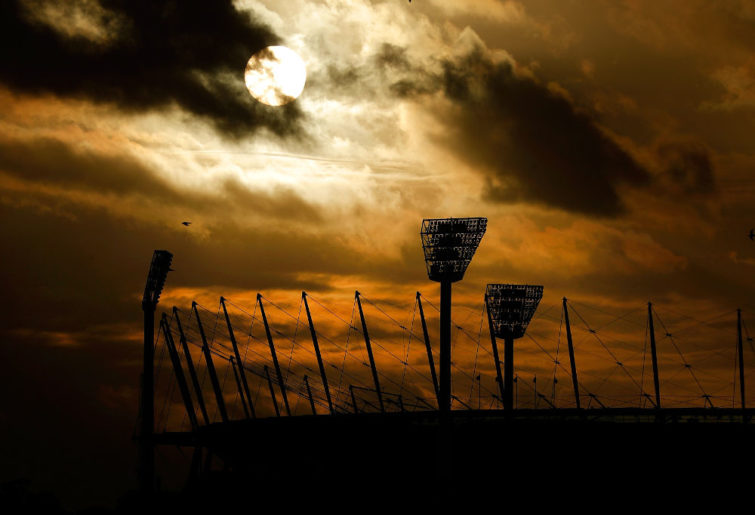
(Michael Willson/AFL Media/Getty Images)
David Neitz (Melbourne 1993-2008)
306 games, 631 goals
In the illustrious history of the Melbourne Football Club, no one has played more games or kicked more goals than David Neitz. He was able to play with great effect at either end of the field, having been named All Australian in 1995 for his play at centre half back and in 2002 at full forward. Neitz led Melbourne’s goal-kicking on seven occasions and won the club’s best and fairest in 2002. He retired in 2008 after sustaining a severe neck injury, having become the club’s record holder in games played, goals kicked, and games as captain.
Tim Notting (Brisbane 1998-2009)
208 games, 138 goals
Tim Notting was a less decorated member of Brisbane’s great sides of the early 2000s, but he was no less effective for it. Best known for his long kicking into the forward 50, Notting was nominated for the Rising Star award in 1999 and played in the 2001 and 2002 premierships, missing 2003 through injury. Best used as a linkman for the Lions, he continued to play at a high level as they started to drop down the ladder, retiring in 2009. Notting was named on the interchange bench of Brisbane’s Team of the Decade.
Interchange
Doug Nicholls (Fitzroy 1932-37)
54 games, two goals
Sir Doug Nicholls’ influence on Australia permeated far beyond the footy field. As a star for Northcote in the VFA dashing down the wing, he initially crossed to Carlton to make his way in the VFL but was snubbed. Insulted, he went to Fitzroy, befriending Haydn Bunton and becoming the first Indigenous player to represent Victoria in a State of Origin match, playing four in total. While Nicholls didn’t achieve any great awards recognition – his best finish was a third place in Fitzroy’s best and fairest – his tireless activism and community work saw him ordained as a minister in 1942, a key proponent in the 1967 referendum, the first Indigenous Australian to be knighted in 1972, and Governor of South Australia in 1976-77. Nicholls’ great-grandson Nathan Lovett-Murray was a regular in Essendon’s sides of the mid-2000s.
Nic Naitanui (West Coast 2009-)
175 games, 105 goals
One of the most exciting players of the 2010s when injury allowed, Nic Naitanui is a high leaping ruckman with great athletic ability and a knack for big moments – an after-the-siren goal in 2013 following a big pack mark was one of the first examples of this. He won Mark of the Year in 2015 with a leap over Mark Blicavs, and has been capable of big impacts on games even with low disposal numbers. Naitanui was named All Australian in 2012, and missed the 2018 premiership through an injury to his knee. In 2020 he is back leading the Eagles’ ruck and looks set to do so for several more years.
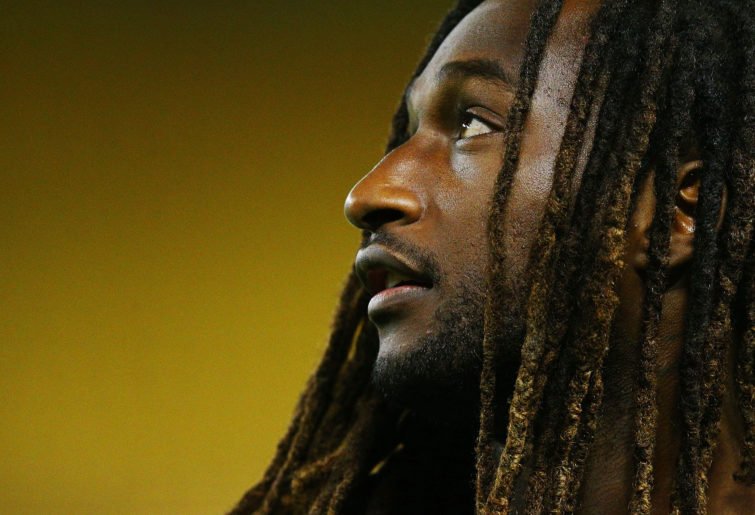
(Photo by Michael Dodge/Getty Images)
Chris Naish (Richmond 1990-97, Port Adelaide 1998-99)
161 games, 228 goals
Chris Naish was a clever and inventive rover for Richmond, who needed only a sniff in order to make a beeline for goal. In 1990, he won Richmond’s reserves best and fairest, before developing into a consistent player throughout the decade. In 1991, Naish represented Victoria, and in the mid 1990s played every match for three straight seasons before form started to wane. Despite this, he was seen as an astute pickup for Port Adelaide, but injury concerns in 1999 brought an end to his career.
Jason Norrish (Melbourne 1993-94, Fremantle 1995-2002)
148 games, 25 goals
Selected at number five in the 1991 AFL Draft, Jason Norrish spent two seasons at Melbourne to no great effect before returning to WA as part of the inaugural Fremantle squad. Injury interrupted his first few years at the club, but he found a niche as a nullifying midfielder who provided essential balance to an attacking team set-up. In 1998, Norrish won Fremantle’s best and fairest, and he was named as vice captain for 1999. After retiring in 2002 he spent one more season at Claremont in the VFL before hanging up the boots for good.
Emergencies
David Norman (Collingwood 1961-66)
91 games, 148 goals
Strong and tenacious when hunting the ball, David Norman was a star at North Ballarat before Collingwood recruited him to the VFL. As a rover who could rest in the forward pocket, three times Norman kicked over 30 goals in a season, leading the club’s goal-kicking in 1965. He played in the club’s 1964 grand final defeat, and departed the club after 1966 to return to the Ballarat Football League.
Matthew Nicks (Sydney 1996-2005)
175 games, 125 goals
Over the course of a decade, Matthew Nicks was a handy utility for Sydney and capable of playing in almost any position. Most often used in the midfield, he was named as Sydney’s Rising Star in 1996 and the club’s most improved player in 1998. A host of injuries interrupted Nicks’ career, including a broken leg, pneumonia, a broken finger, and stress fractures. In 2002 Nicks kicked a career-high 28 goals before starting to lose impact and finally losing his place in the team in 2005, thus missing out on the club’s breakthrough premiership.
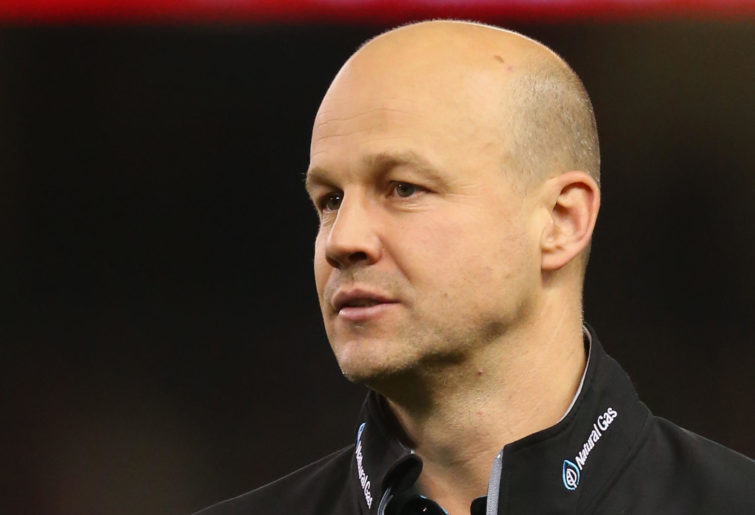
(Photo by Quinn Rooney/Getty Images)
Mick Nolan (North Melbourne 1973-80)
107 games, 40 goals
Mick Nolan had one of the great footy nicknames bestowed upon him by Lou Richards – the Galloping Gasometer. Nolan was one of the heaviest players to have played league footy, however this did not dull his effectiveness as a tap ruckman or when competing for the ball at ground level. A video on YouTube shows the his strength, as he simply held his ground against a ferocious bump from Mark Maclure and went about the game. Nolan played in the 1975 premiership and finished third in the best and fairest that year, but missed the 1977 premiership through injury. After retiring from the VFL, he moved to Queensland as part of the league’s attempts to build the game in the state.
Up next is the O team, with some solid contributors and great characters, plus a four-club key forward who featured in Channel Seven’s coverage after his career ended.


































































































